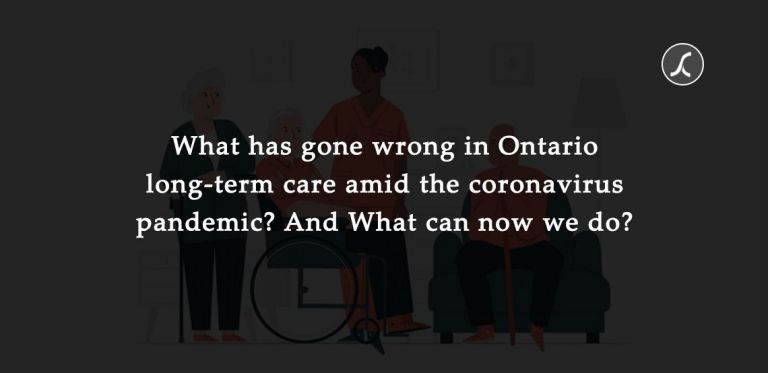436 Facility Outbreaks in Ontario: How Technology Helps Us Avoid COVID-19 Outbreaks in LTC homes and Save Our Seniors?

4 years ago
While Canadians are busy making their holiday plan, the long term care facilities are struggling to keep residents safe from coronavirus.
Though this is the data of US-based long term care homes, Canada is not far behind with more than 2200 resident deaths in Ontario only.
However, the infection rate and mortality rate among residents are different in various provinces.
The following image clearly depicts how well British Columbia achieved a much lower infection rate and mortality rate than Ontario.
Despite everything we achieved, we lost more.
Following are the worst affected long-term care homes in Toronto only after just one month of the pandemic in Canada.
Thus, it is worth asking, are long term care near me safe?
What makes ‘long term care near me’ unsafe for residents during the pandemic?
To identify the reasons why long term care homes in Ontario emerged as more unsafe than LTC homes in B.C., we need to compare both provinces with respect to several factors such as,
- Existing Medical Condition of Residents
A more percentage of Ontario-based residents have existing diseases such as diabetes, hypertension, dementia, and asthma than British Columbia-based residents.
Meaning, residents of Ontario-based long term care homes seek more accurate, effective, and quality treatment.
- Direct Care Hours
Though residents in Ontario require more direct care hours due to their existing medical condition, residents in British Columbia receive more daily hours of direct care (3.25) than residents in Ontario (2.71).
- Staffing
Due to a lower budget for long term care homes than B.C., the medical professionals working in Ontario-based LTC homes receive low pay.
Thus, they are less likely to secure a full-time position.
As a result, a long term care home needs to fill many part-time positions that increase the number of people a resident comes in direct contact with.
- Staff Engagement
As there is a severe staff shortage in Ontario-based long term care facilities, the available staff always need to be on edge and look after more residents than average.
Extensive paperwork and administrative work worsen the situation and make them overwhelmed.
As an upshot, they cannot invest more hours in providing quality care to residents.
- Visitor Policy
Given the fact that the asymptomatic visitors to long term care homes can transmit the virus to the residents, visitor movement in long term care facilities has been restricted.
Though this was a purposeful decision, it pushed residents to social isolation that drastically affected their well-being and mental health.
How can technologies make long term care homes safer for residents during and beyond COVID-19?
For most people, technology is fun. But for doctors, it is the third arm!
Following are the top use cases of different technologies in long term care homes.
Use Case: Rapid and Remote Care
Technology: Virtual Care
A virtual care solution allows healthcare professionals to provide quality care via an interactive and secure live video call.
It reduces the time-to-delivery by more than 80% as a doctor can treat patients from anywhere in the world.
Most importantly, it eliminates direct contact between the doctor and the resident.
Use Case: Improved Mental Health
Technology: Virtual Care
The same virtual care solution can be used to arrange video calls between residents and their family members.
Here, the uninterrupted internet access at the universal speed at each bed plays a crucial role.
It is worth mentioning that LTC homes should avoid using any general-purpose free video calling apps as these apps aren’t PHIPA and HIPAA compliant - in other words - aren’t secure.
Use Case: Make Staff Less Burdened / Add Up Time For Them
Technology: Robotic Process Automation (RPA)
A software-based robot developed using RPA technology gets installed on a desktop and constantly performs tasks automatically with high accuracy.
This will eventually free up staff from repetitive and time-consuming tasks and they can invest this saved time in providing better direct care to residents.
Use Case: 100% Contactless Care Delivery
Technology: Remote Patient Monitoring
It is not feasible for healthcare professionals to measure the biometric value of residents such as blood pressure, glucose level without being in physical contact with them.
But with a remote patient monitoring system or device that a resident can easily wear, a healthcare provider can know the real-time biometric value of the resident from the mobile.
Most importantly, it alerts the caretaker in case of an emergency and enables doctors to explore the historic biometric data.
In essence, the long term care homes that adopt the technologies are safer. Here are some proofs.
Since the pandemic hit Canada, our entire team has been working closely with many LTC homes.
We’ve witnessed how LTC home once struggling emerged as the winner when it comes to saving our seniors.
Here, I am sharing two case studies to not showcase our skills or expertise but to showcase how urgent technology adoption is for the safety of residents.
Proof 1: A long term care home reduced administrative burdens and paperwork by 63%? Explore how.
Proof 2: A long term care home provided a safer environment to residents only with uninterrupted internet access? Explore how.
